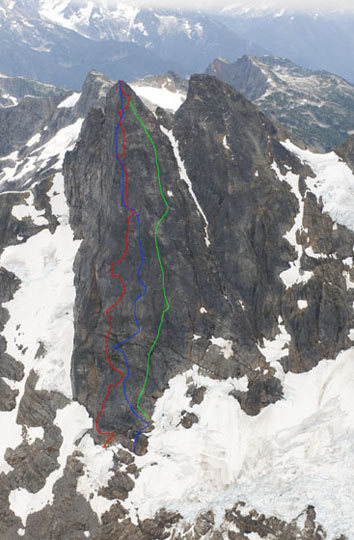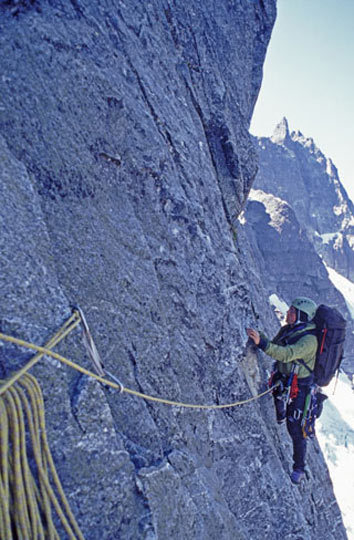
The north face of East McMillan Spire (7,992′), Southern Pickets, Cascades, Washington, showing the North Face (1976) in green, the North Buttress (1986) in blue and Alan Kearney and Erik Johnson’s new route, Come Over To The Dark Side (V 5.10-, 25 pitches, 2008), in red. The Spire is remote, requiring a couple days of bushwhacking to get to its base, and the 2,400′ north face is known for runout, compact Skagit gneiss. The pair placed no bolts on the new line, which they climbed from September 6-8. [Photo] Alan Kearney
Alan Kearney has been at it again on East McMillan Spire (7,992′) in the Southern Pickets, Cascades, Washington. In 2002 he made the second ascent of its North Buttress (V 5.9, 27 pitches, ca. 2,500′); this time, with Erik Johnson, he found an unclimbed line that weaves twenty-five pitches–fourteen of them new–left of the North Buttress and North Face routes. Kearney noted that Come Over To The Dark Side (V 5.10-) was “one of the longest and more remote walls I’ve climbed in the Cascades. It is an elegant and striking face that may even yield another line or two.”
After two days of bushwhacking, Kearney and Johnson camped on Sourdough Ridge the night of September 5, 2008. The next morning they hiked 3.5 hours to get to the northern base of East McMillan, and they climbed seven pitches in seven hours to their first bivy. On the 7th they climbed seven more, including the crux pitches, despite routefinding trouble. And on the 8th they went fast and light from their second bivy to make a four-hour, eleven-pitch blast to the summit. They rapped to the base that same day via the upper North Face, part of the North Buttress and, finally, the Northeast Buttress.
The new route involved mostly 5.6-8 climbing, a handful of 5.9 lengths and three or four pitches of 5.10- on compact Skagit gneiss with few cracks. Kearney and Johnson placed small cams and numerous knifeblade and bugaboo pitons when possible (read: relatively infrequently). They drilled no bolts and found the routefinding complex, and protection difficult. Kearney added that “Erik considered carrying our small bolt kit with him up the hardest pitch, took a long contemplative look upward, and then left it behind.”
Kearney had spotted the line in 2002 while on the North Buttress. His two previous attempts, in 2003 and 2006, were unsuccessful: “These bigger faces in the Cascades haven’t been climbed because of weather, access, rock quality and visibility,” Kearney said. He attributes some of the recent Cascades psych and development to the aerial photos of John Scurlock, pilot and author of “Behind the Veil” in Issue 21, and to the fact that the new actors in the game are paying close attention to what has been climbed in the past.

Johnson follows an “improbable traverse [that] avoided a huge blank overhang above and drew us to the start of seams and discontinuous small cracks of the crux pitch,” Kearney said. [Photo] Alan Kearney
As Kearney writes in “Life on Top” in Issue 22, much of his climbing life has been dedicated to the Cascades. This summer he climbed Sloan Peak, South Early Winter Spire, Prusik Peak and the Pickets Traverse. “The key to the big unclimbed and inaccessible projects is finding the right partner that shares the same passion as me,” he said. “It’s not about brilliant moves on perfect rock but rather the feeling of being on an awesome face with beetling overhangs and wondering if the route will go or not.”
“When it takes you almost three days to get to the base of a climb, it’s unlikely that everything aligns. But lots more will get done–lately there has been a huge upsurge of interest in these peaks by younger climbers: Blake Herrington, Mike Layton, Colin Haley. For some of these big faces, it will take winter or autumn conditions to hold some of the rock together, but it’s just a matter of time.”